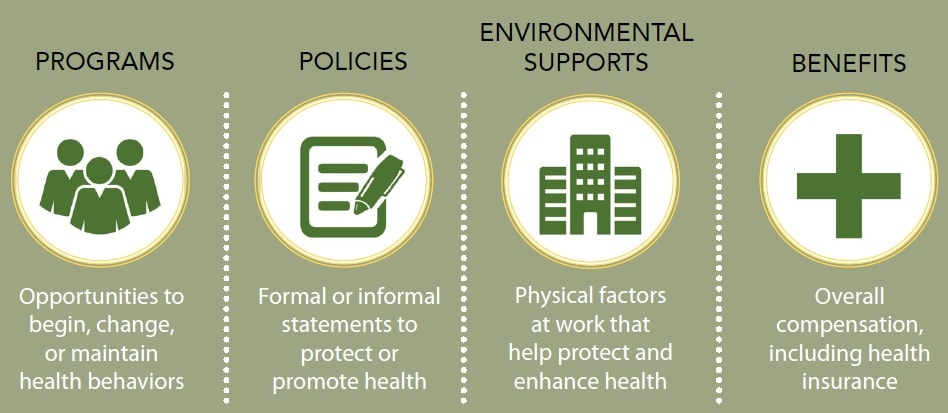2020 Employer Nutrition Program Profile
The CDC ScoreCard is a tool to help employers assess whether their health promotion programs are based on the best evidence for improving employees’ health and wellness.
Available for Download pdf icon[PDF – 624 KB]
What Evidence-Based Practices Does the ScoreCard Assess?

Millions of Americans get food at work each day. Improving access to healthy food and beverages at the worksite to improve diet is a key component of a workplace nutrition program. People who eat a healthy diet live longer and are at lower risk for serious health problems such as heart disease, type 2 diabetes, and obesity. For those with these conditions, healthy eating can help manage them and prevent complications.
How Are Employers Doing in Promoting Healthy Eating?
44% of employers have a comprehensive workplace nutrition programs including policies and environmental support strategies.
47% of employers have a policy strategy (e.g., healthy foods at meetings or subsidies) to improve healthy food and beverage access and availability as part of their worksite nutrition program.
On average, employers have 57%, or 8 of 14 Nutrition ScoreCard strategies in place.
Nutrition ScoreCard Strategies |
Strategy a |
% of Worksites With Strategy in Place (2020 Score) |
|---|---|---|
| Food Preparation and Storage | Provide employees with food preparation and storage facilities and a place to eat |
96% b |
| Access to Drinking Water | Promote and provide access for increased water consumption | 90% b |
| Educational Materials | Provide educational materials that address healthy eating | 79% b |
| Ways to Purchase Food | Provide places to purchase food and beverages | 75% b |
| Educational Programming | Provide and promote interactive educational programming on nutrition, such as a series of educational seminars, workshops, or classes on nutrition | 67% b |
| Free or Subsidized Counseling | Provide and promote free or subsidized coaching, counseling, or self-management programs that equip employees with skills and motivation to set and meet their personal nutrition goals | 66% b |
| Available Farmer’s Market | Offer or promote an on-site or nearby farmers’ market where fresh fruits and vegetables are sold | 44% b |
| Food Options | Make most items in vending machines, cafeterias, and snack bars healthy | 43% c |
| Food Options Packaging | Identify healthier food and beverage choices with signs or symbols |
42% c |
| Nutrition Labels | Label foods with nutritional information | 38% c |
| Policies | Have a written policy that makes healthier food and beverage choices available in cafeterias or snack bars | 38% c |
| Policies | Have a written policy that makes healthier food and beverage choices available in vending machines | 36% c |
| Policies | Have a written policy that makes healthier food and beverage choices available during meetings when food is served | 28% b |
| Pricing | Use pricing to encourage purchase of healthy options | 24% c |
a Evidence-based practices (i.e., programs, policies, environmental supports, and benefits) in the CDC Worksite Health ScoreCard have a weighted score from 1 to 3 points. The score is derived from the strategy’s impact on population health outcomes and the strength of the supporting scientific evidence.
b Percentages are based on 480 ScoreCard submissions in 2020.
c Percentages are based on 359 ScoreCard submissions from employers who reported providing places to purchase food and beverages in 2020.